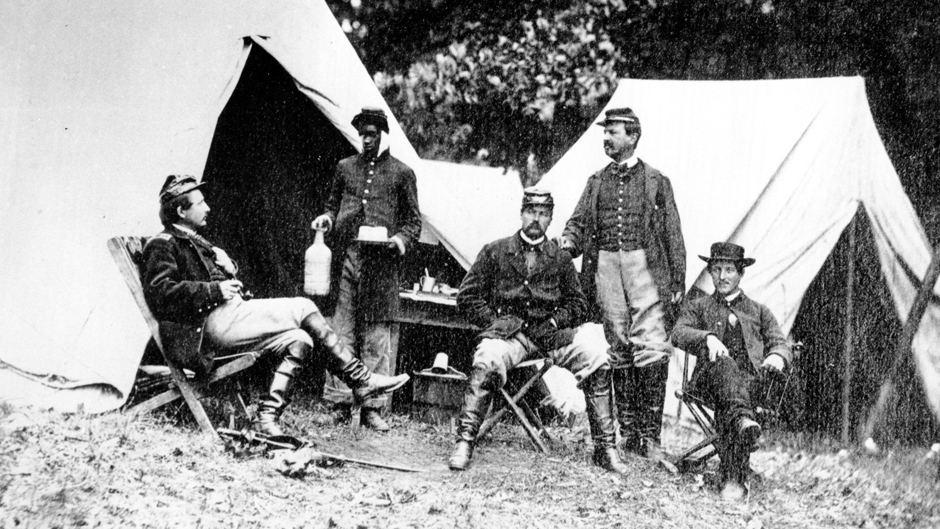The Memorial Day holiday that we celebrate on the last Monday in May with a long weekend, backyard barbecues, and a salute to the oncoming summer has its beginnings in the Civil War—“a war that is cataclysmic in a way that no other American conflict even approaches.”
“For the first half of its life, Memorial Day was exclusively a Civil War holiday, and specifically, a Union holiday. It then gets expanded in the 20th century to encompass all American soldiers who fell in service and so becomes universal,” explained Michael Bernath, an associate professor of history in the University of Miami College of Arts and Sciences.

The first official observance of Decoration Day—the holiday’s original moniker—was May 30, 1868. Union Army Maj. Gen. John A. Logan, the first commander-in-chief of the organization of Union veterans called the Grand Army of the Republic (GAR), proclaimed the holiday “for the purpose of strewing flowers or otherwise decorating the graves of comrades who died in defense of their country and conduct special ceremonies as permitted.”
Yet Bernath, with expertise in Southern history and the Civil War era, highlighted that “there are a lot of competing claims going back to the first days of the war” in terms of place and date for the birthplace of Memorial Day.
One that took place on the Washington Race Course in Charleston in 1865, investigated by Yale history professor David Blight and reported in at least two newspaper accounts of the time, Bernath finds particularly symbolic.
A large group of formerly enslaved free people—reportedly 10,000—staged a parade to honor several hundred Union POWs who had died from exposure and disease while held at what was once an open-air makeshift prison. The bodies were moved from a mass grave behind the track and reinterred in a nearby cemetery.
“Given the size of the event in Charleston, who’s conducting it, and the fact it was held in the cradle of secession, on the racetrack where the slaveholding elite would play—there’s a lot to unpack about that observance,” he noted.
Regardless the exact date of the first Decoration Day, Bernath highlighted the horrors of the Civil War, a conflict that “while it seems remote is really only a few handshakes away”—in terms of knowing someone who knew someone who was a veteran of the war.
“The Civil War dwarfs all other American conflicts by an amazing margin,” said Bernath. “More [people] died in the Civil War than in all other American conflicts combined from American Revolution up to yesterday. And that’s just a raw number.”
Bernath estimated that 750,000 soldiers on both sides died. Given the 1860 population of 31 million, that’s more than 2 percent of the population—for the U.S. population today the equivalent would be some 8 million.
“Nothing else even comes close in terms of loss,” he said. “We really have no idea of the number of civilian deaths, and together with the destruction of property, the destruction of the entire southern half of the country, it’s cataclysmic in a way that no other American conflict even approaches.”
More than one in five white men of military age in the Confederate states died in the war.
“The number of widows, of orphans, of women who would never find husbands is enormous. The loss of so many, so quickly will have a ripple effect for generations afterwards,” he noted.
What prompted these young men—many of them in their teens—to make the ultimate sacrifice?
The motivations are hard to decipher and must be differentiated between white Northerners, white Southerners, and Black soldiers, according to Bernath.
“These men were not inclined to throw their lives away. These are regular people, overwhelmingly volunteers, not well trained or disciplined,” he noted. “Understanding how to motivate them to march into these situations remains a puzzle for historians and contemporary leaders to this day.”
For those in the South, white supremacy was a powerful motivation along with the rational given for secession—fighting to preserve slavery.
Soldiers in the North would probably have said they were fighting for the Union.
“But the idea that you would sacrifice so much for such an abstract concept remains hard for us to grasp today,” Bernath said. “We live in a much more cynical age that tends to view such patriotic talk with a great deal of skepticism.”
Yet, as do conflicts throughout history, once the fighting starts “it compounds upon itself,” he said.
“Once blood is shed, once the flag is fired on, once Fort Sumter happens—the war takes on a life of its own—these dead cannot be allowed to die in vain—and becomes self-justifying to a certain extent,” Bernath said.
While Americans of the time were far more religious overall, for those facing the end of their lives one of the pervading intentions was to experience “a good death,” he explained.
“‘A good death wasn’t necessarily a sudden death in service of a cause, but instead the notion of facing death squarely, seeing it coming, and accepting it with ‘coolness’—a unique quality of the era,” Bernath said.
“It was supremely important for loved ones to know where their soldier had fallen and to have the assurance that he had a good death. And any final words uttered on the death bed were especially reassuring for the living,” Bernath said. “These are not zealots marching off to their martyrdom; these boys did not want to die.”
The need to commemorate and recognize the dead is certainly not new to the Civil War, Bernath highlighted. He noted, too, that while Decoration Day was created by the GAR, the primary Union veterans’ organization, the Confederates created their own Memorial Day, which is still recognized in a number of southern states, including Florida.
State offices in the Sunshine State no longer close, but Confederate Memorial Day, celebrated on April 26, is one of three Confederate holidays still on the Florida calendar.

